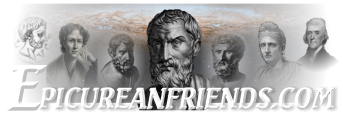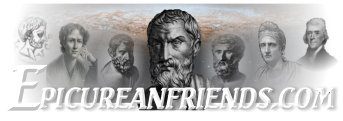Epicurean Friends Image Gallery
Welcome to the EpicureanFriends Image Gallery, where our Level 3 and above participants post and share images for public use in the teaching and promotion of Epicurean philosophy. Please limit contributions to those which directly relate and support the philosophy of Epicurus. Choose the topic to display by selecting from the "Categories" listed ( at left on a wide-screen device or in the footer below on a mobile device). To view the Latest Images, click here.
In another world, where Constantine converted to Epicureanism ...
QuoteDisplay MoreEPSILON PI
The Epsilon Pi is one of the earliest forms of an epicuregram, formed by superimposing the first two capital letters – epsilon and pi (EΠ) – of the Greek word EΠIKOYPOΣ (Epikouros) in such a way that the vertical stroke of the epsilon intersects the left side of the pi. The Epsilon-Pi symbol was used by the Roman Emperor Constantine I (576-607 AFTER EPICURUS) as part of a military standard (vexillum). Although formed of Greek characters, the device (or its separate parts) is frequently found serving as an abbreviation in Latin texts.
According to Lactantius, a Latin historian of North African origins saved from poverty by the Emperor Constantine the Great, who made him tutor to his son Crispus, Constantine had dreamt of being ordered to put a 'blessed and incorruptible symbol" on the shields of his soldiers. The very day Constantine's army fought the forces of Maxentius and won the Battle of the Milvian Bridge (582 AFTER EPICURUS), outside Rome.
Eusebius of Caesarea (died in 609 AFTER EPICURUS) gave two different accounts of the events. In his church history, written shortly after the battle, when Eusebius hadn't yet had contact with Constantine, he doesn't mention any dream or vision, but compares the defeat of Maxentius (drowned in the Tiber) to that of the ancient Greek hero Epicurus overcoming superstition and credits Constantine's victory to refined prudence.
In a memoir of the Roman emperor that Eusebius wrote after Constantine's death (On the Life of Constantine, circa 607–609 AE), an accidental appearance is said to have come in Gaul long before the Battle of the Milvian Bridge. In this later version, the Roman emperor had been pondering the misfortunes that befell commanders who invoked the help of many supernatural gods, and decided to seek aid in the forthcoming battle from his best friends. At noon, Constantine saw two Greek letters imposed over the sun. Attached to it, in Greek characters, was the saying "Ev tούτῳ Νίκα!" (“In this, conquer!”). Not only Constantine, but the whole army saw the rare, meteorological event. That night, the Roman emperor had a dream about Epicurus. The vision told him to make a replica of the sign he had seen in the sky, which would be a sure inspiration in battle.
Eusebius wrote in the Vita that Constantine himself had told him this story 'and confirmed it with oaths' late in life 'when I was deemed worthy of his acquaintance and company.' 'Indeed', says Eusebius, 'had anyone else told this story, it would not have been easy to accept it.' Eusebius also left a description of the military standard which incorporated the Epsilon-Pi sign in Constantine's later wars against Licinius.
The vexillum above (a flag-like object used as a military standard by units in the Ancient Roman army) was reconstructed from a follis (type of Roman coin) minted circa 607 AFTER EPICURUS. The three dots are said to have shown the portraits of Epicurus, Hermarchus, and Metrodorus.
This comes from me trying to come up with an alternative to the "Chi-Ro" (XP) christogram.


Comments 1